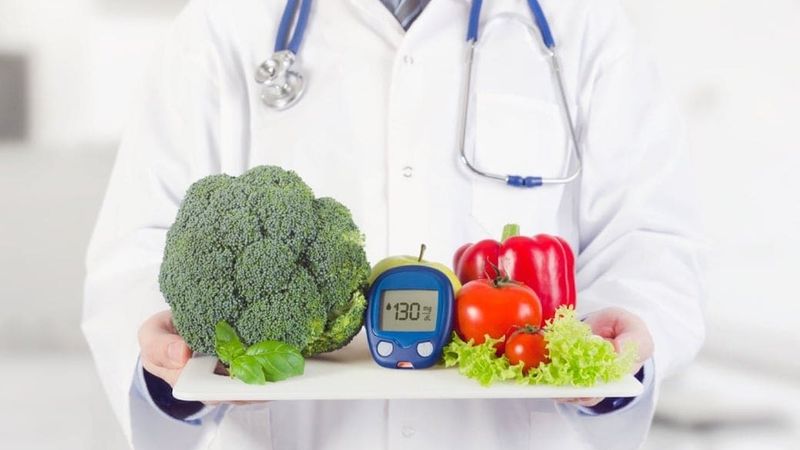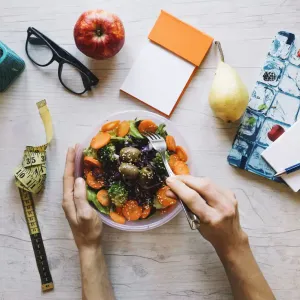

Our Review Process
Our articles undergo extensive medical review by board-certified practitioners to confirm that all factual inferences with respect to medical conditions, symptoms, treatments, and protocols are legitimate, canonical, and adhere to current guidelines and the latest discoveries. Read more.
Our Editorial Team
Shifa Fatima, MSc.
Author
Dr. Apoorva T, MHM.
MEDICAL ADVISOR
Ideal Diabetes Nutrition Plan
The cases of diabetes are on the rise and in the last decade, the recorded number of cases has increased considerably. There are many known causes of diabetes and although there is no particular cure, the best way to manage the effects is to monitor your diet. Apart from the medication prescribed by the doctor, the effects of your diet are quick and can be felt almost immediately on your health. Let us take a look at some foods that can help you lead a healthy lifestyle and ensure you are safe from the effects of diabetes as well. Also know how to get freedom from diabetes?
Table of Contents
Best food for diabetes control
The factor that qualifies you as a diabetic is the surge of sugar levels in your blood. These may be caused due to a lack of insulin, it may be genetic, it may be due to physical inactivity and obesity, and so on. If the sugar levels in the blood increase or decrease, the vital organs get affected. The diet you follow can, directly and indirectly, affect the factors that control the blood sugar level. This means you should actively avoid food groups that ultimately break down into sugars as well. This includes carbohydrates and starch as well. If you are wondering what foods diabetics can eat freely, Here are the answers to what should a diabetic patient eat when on a diet to maintain their blood sugar levels. Read more to know about diet for diabetes.
List of best Foods for Diabetes can eat freely
If you have prediabetes or diabetes, you can improve your condition by taking a healthy and balanced diet. Choosing food items rich in nutritional profile can keep you feeling fuller for very longer periods and provide your body with essential nutrients for proper functioning. To help you prepare a reliable food list for diabetes, we have shared below all the food items you can include in your diabetes-friendly diet. Also know about sugar diet chart
Vegetables for Diabetes
Vegetables are the best foods diabetics can eat because of their rich vitamin, mineral, and fiber content. Most vegetables contain a high amount of complex carbohydrates and fiber, making people feel satiated. It prevents people from overeating, leading to blood sugar problems and weight gain. To get the maximum benefits of a healthy diet, include the following vegetables in your diet:
- Corn
- Broccoli
- Tomatoes
- Green Peas
- Carrots
- Leafy greens like spinach
- Potatoes
You can also include zucchini, cabbage, cucumber, mushrooms, and green beans in your daily diet.
Beans & Legumes for Diabetes
Legumes and beans are excellent sources of protein and dietary fiber. Since these food items contain high fiber, fewer carbohydrates get absorbed by the digestive tract. Although numerous beans and legumes are available in the market, the following are considered good foods for diabetics.
- Kidney beans
- Black beans
- Pinto beans
- Lentils
- White beans
- Garbanzo beans
Slow-cooking or pressure-cooking beans and legumes are the best way to enhance their digestibility.
Fruits for Diabetes
There are plenty of foods diabetics can eat, and fresh fruits top the chart. They may have high sugar content, but sugars in whole fruits are not considered free sugar; hence, people with diabetes can enjoy most fruits. You can enjoy the following fruits in your diabetes plan because of their low GI index.
- Plums
- Apples
- Avocado
- Pears
- Blackberries
- Grapefruit
- Peaches
- Cherries
- Strawberries
You can also include other seasonal fruits of your choice, provided they are consumed in moderation. If your selection of fruit has a high GI, restrict its consumption to meet your daily calorie and nutritional requirement.
Whole Grains for Diabetes
Besides legumes and beans, whole grains are considered healthy foods for diabetics. Most whole grains are effective at managing healthy blood glucose levels because of their low GI. Instead of consuming refined and bleached carbohydrates like pasta, white bread, etc., you should eat more whole grains for a better-functioning body. The following whole grains can be excellent additions to your diabetes-friendly diet:
- Millet
- Quinoa
- Whole-grain bread
- Barley
- Amaranth
- Wild rice
- Cornmeal
- Oatmeal
- 100% whole wheat flour
Most whole grains will leave you feeling full, stopping you from overeating. They are even more flavorful than food items high in processed carbohydrates.
Dairy for Diabetes
It can be surprising to some, but dairy can be some of the best foods for diabetes diet chart. Dairy products are pretty rich in calcium, protein, and other essential nutrients. According to some research studies, dairy products have positive effects on insulin secretion in some diabetic individuals. If you are diagnosed with diabetes, you can include the following dairy:
- Low-fat Greek yogurt
- Parmesan, ricotta, or cottage cheese
- Low-fat Plain yogurt
- Low-fat or skimmed milk
Meat for Diabetes
Non-vegetarians diagnosed with diabetes can rely on meat to fulfill their protein requirement. Considered one of the best foods to control diabetes, meat is high in fiber, healthy fat, and protein. Since meat results in a mild increase in blood sugar, people with diabetes can consume it without worry. The following meat items are considered suitable for consumption:
- Eggs
- Skinless and boneless chicken breasts
- White fish fillets
- Skinless and boneless chicken strips
- Skinless turkey breast
- Salmon, Tuna, Sardines, and other oily fish
Drinks for Diabetes
Now that you have seen plenty of options for meat, fruits, dairy, whole grains, and vegetables for diabetics to eat, let’s quickly check some drink options that won’t spike your blood sugar levels. The following drinks can be included in your regular diabetes-friendly diet:
- Unsweetened plant-based milk
- Unsweetened hot/cold tea
- Low-fat or skimmed milk
- Sparkling water
- Unsweetened coffee
Other Food Items to Include in Diabetes-Friendly Diet
Vegetarians can rely on plant-based proteins like lentils, tofu, falafel, hummus, and tempeh to maintain healthy glucose levels. If you don’t like your food bland, use seasonings like hot sauces, olive oil, vinegar, any organic spice or herb, salsa, mustard, etc., to enhance the taste of your food. These are diabetes-friendly and can be added to your food without worry. People with a sweet tooth can consider including 100% fruit popsicles, desserts featuring sugar-free gelatin, popsicles without sugar, and puddings made with zero-calorie sweeteners. We would suggest sticking more with natural foods for diabetes for the best results.
Foods and Drinks to Limit in Diabetes
Although most people with diabetes receive a general suggestion of choosing sugar free foods for diabetics, we have better recommendations for you. To maintain healthy blood glucose levels, you should avoid food items high in saturated fat, trans fat, simple carbohydrates, and sugar. Some food items you should avoid or try to limit are:
- White rice
- White bread
- White pasta
- Red meat
- Sugary cereals
- Sugary drinks
- Processed meat
Additionally, it is also recommended to avoid low-fat food items that have replaced fat with sugar. Take fat-free yogurt as an example. If you have prediabetes or diabetes, consider replacing these items with their healthier versions. For instance, white pasta can be replaced with whole wheat pasta, and white rice can be replaced with brown rice, and so on. If you eat a lot of junk food from restaurants, we’d suggest having more homemade meals since it is easier to control the amount of sugar in the food. You can also make healthier and diabetes-friendly versions of your favorite recipes at home.

When Should I Eat if I Have Diabetes?
Although there is no fixed time to eat, try to eat at the same time every day. If your work doesn’t allow you to have meals at a fixed time, you can adopt a flexible timing approach, as long as you don’t start skipping meals. You should adjust your meal timings depending on your medication and insulin type (if you are taking insulin injections). The best option is to consult your doctor regarding the ideal meal timing.
How Much Can I Eat if I Have Diabetes?
A diabetes patient is expected to eat three meals a day. The meals should be consumed at the same time, but a flexible timing approach can also be followed. Sticking to the same meal routine helps your body better use insulin. How much food you should consume and in what proportion can only be determined by a professional nutritionist after evaluating a thorough body checkup. A personalized meal plan and meal quantity recommendations are made based on an individual’s health goals, lifestyle, and taste preferences. So we’d suggest talking to your nutritionist to determine the ideal amount of food you can consume for healthy living.
Bottomline
Are you a diabetic looking for a solution to your diet restrictions? If you are, here is the answer for you. Include these high fibre and protein items in your meals to rein in your sugar levels. These foods will benefit you by providing you with the necessary nourishment that will refill the depleted supply and provide your body with the nutrients required to lead an active and healthy life. You can indulge in these foods without hesitating about your health and enjoy the goodness of essential fats without worrying about the implications. Perfect for managing any type of diabetes, these will help you in the long run as well.
FAQs
What foods contain no added sugar?
There are plenty of sugar-free food options for diabetics. These items help to regulate blood sugar levels to lead a healthy life. The foods with no added sugar are seafood, pork, chicken, nuts, seeds, green leafy vegetables, avocados, eggs, etc. Having the right food choices is an important decision for a diabetic to have a complication-free life.
What vegetable has no sugar?
Vegetables that have zero to a negligible amount of sugar are best for diabetics. Apart from having no sugar, consumption of these vegetables provides vital vitamins and nutrients. Vegetables that a diabetic must include in the diet are lettuce, beetroot, cabbage, broccoli, cauliflower, spinach, mushrooms, kale, arugula, radish, etc. Including these vegetables in your diet can help you to maintain stable blood sugar levels.
What time of day is your blood sugar the highest?
Generally, the highest blood sugar level is recorded early morning between 2:00 am to 8:00 am. As the body uses the stored glucose to prepare for the next day, this process causes high blood sugar levels in the early morning hours. This is also commonly known as the dawn effect.
References
- https://www.medicalnewstoday.com/articles/324416#beans
Disclaimer
This website's content is provided only for educational reasons and is not meant to be a replacement for professional medical advice. Due to individual differences, the reader should contact their physician to decide whether the material is applicable to their case.








